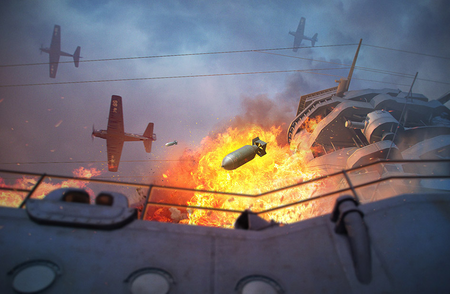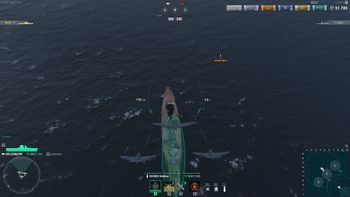Bombers/temp
Contents
Air Group Baselines
Bombers are able to carry following areal bombs:
- high-explosive (HE);
- armor-piercing (AP).
This type of aircraft are also marked by following differences of their bombs:
- armor piercing performance;
- damage performance.
Additionally, HE bombs can cause a fire on an enemy ship. The fire chance can be increased as follow:
- using flag signals Victor Lima and India X-Ray — by +1%;
- learning "Demolition Expert" commander skill — by +2%.
Moreover, some aircraft carry not one but several bombs.
The sight of bombers looks different from that of torpedo bombers. The damage area is an oval so the most effective attack should be performed from the stern/bow. In this case the damage area will be maximal and the probability of a successful hit increases.
The distance of the sight depends on the aircraft current speed, it`s height and pitch. Please keep in mind that the dive bombers sight moves rather slowly when climbing and diving and accelerates when approaching the target.
British bombers drop bombs in a different way: during the horizontal flight and in large numbers. The scatter ellipse is extended in the direction of the squadron's movement and is larger than that of other nations bombers. A successful approach with this feature allows you to cause significant damages to the enemy ship.
AP areal bombs are a special type of weapon. They can penetrate the ship deck, but at a certain angle — otherwise they will ricochet.
The bomb angle of incidence depends on the pitch of the aircraft. This one, in turn, depends from the approaching time — when the sight appears and the exit countdown begins, the bomb fall angle will change downward.
The bomb drop at the highest point of the trajectory, when the aircraft goes into a dive after the "slide"/climb, will cause that the bomb fall perpendicular to the aircraft — this is ideal against very thick armor. If you drop the bomb at the last moment, when the dive is over and the aircraft is just flying parallel to the water, the incidence angle will be very small, what allow the bomb to arm by hit a weakly armored target. However, it should be borne in mind that in this case you will have no chance to cause much damage to ships with more serious deck armor due to ricochet.
As soon as the bomb makes contact with the armor the usual AP shells mechanics will be used - normalization, ricochet check, armor penetration and aiming.
After aiming the AP bomb, similar to the AP shell, continues it`s path inside the ship. Each encounter with an obstacle cause it`s speed and remaining penetration recalculation, and so for every obstacle meet by the bomb.
Bombers by country






